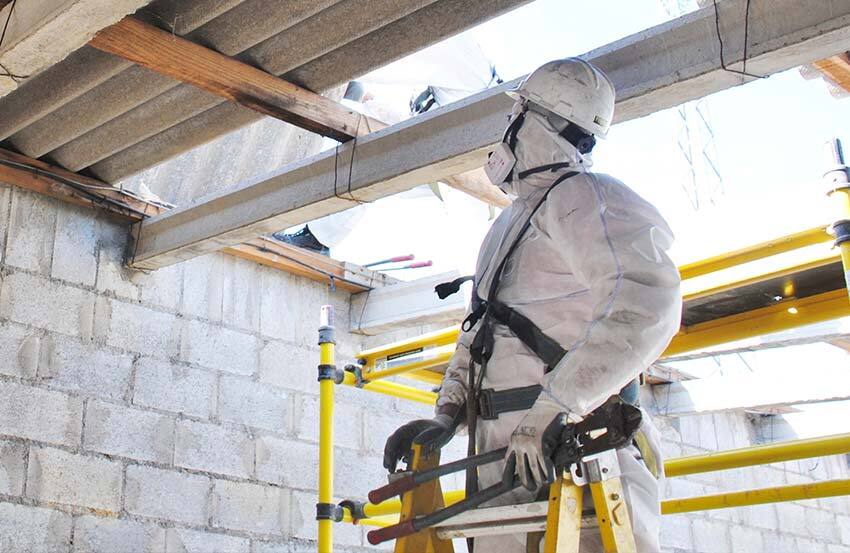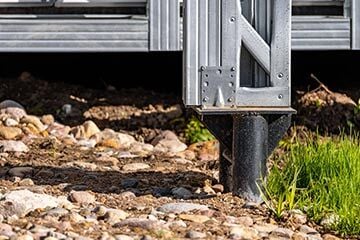Asbestos is a dangerous mineral that used to be heavily used in the building trade. It's not used now, but there are still homes that contain asbestos. In this guide, we'll be looking at what asbestos actually is, and what to do if you find it in your home.

What is asbestos?
For most of us, when we hear 'asbestos', alarm bells start to ring, and quite rightly. There are over 5,000 asbestos related deaths in the UK every year.
Asbestos isn't always dangerous, but it can be during renovations or demolitions. When it's disturbed, asbestos releases harmful fibres that can cause serious health issues, such as:
- Lung cancer
- Mesothelioma - this is a cancer that forms in the lining of the lung
- Asbestosis - this is a long-term disease of the lung
Asbestos is a naturally occurring mineral, but it's not used any more because of these health risks.
Its strength made it an attractive building material. It's resistant to heat, fire, chemical and biological degradation.
Asbestos was commonly used in homes that were built from the 1930s to the mid 1980s. Its use peaked in the 1960s and 70s though. It was finally banned in 1999.
You can find it both inside and outside your home. Here’s where you’ll usually find it lurking:
- Pipe insulation
- Floors or ceiling tiles
- Textured coatings like Artex on walls or ceilings
- Garage roofs
- Internal and external window frames
- Loose fill insulation
- Toilet cistern or in the toilet seat
There are 3 types of asbestos:
-
Amosite or brown asbestos
-
Crocidolite or blue asbestos
-
Chrysotile or white asbestos
The first 2 are the most dangerous forms of asbestos, they were often mixed with cement to make it stronger or used as an adhesive.
Chrysotile was used in homes until 1999. It was more flexible than the others and heat resistant, so it was good for insulating boilers and pipes. It was added to the ban later.
Is there asbestos in my house?
According to Supernova Asbestos services, up to 1.5 million homes in the UK might still have asbestos.
If your home was built after 2000, it's likely your home is asbestos free.
But anything built before then - particularly before 1985 - might have asbestos in it.
You could ask your neighbours to see if they've found any asbestos in their property. Or if you're in an ex-council house, you could contact the council and ask if there's any asbestos present.
Here's some tell-tale signs of asbestos to look out for:
- Ceiling tiles - especially older ones that look soft and fibrous could contain asbestos.
- Textured coatings - especially Artex. This is a sort of swirly, textured pattern either on the ceilings or walls.
- Lagging on pipes - you might find this around boilers. The pipes are wrapped in cloth or paper-type insulation.
- Cement roofs, guttering or downpipes - you might have these in sheds and garages.
- Floor tiles or vinyl flooring - they might have used a bitumen adhesive called 'Blackjack' that contains asbestos.
- Partition walls and soffits - A soffit is the exposed surface underneath the roof overhang. Both these and partition walls can contain asbestos.
But really, it can be hard to spot asbestos with an untrained eye. The best thing you can do is get an asbestos survey.
There are 2 types, a management survey or a refurbishment and demolition survey:
Asbestos management surveys cost between £150 and £350 for 2-3 bedroom homes.
If you're refurbing your home, you'll need a refurbishment and demolition survey. This is more expensive, ranging between £300 to £400 for 2-3 bedroom homes.
Both of these surveys can keep you, your tenants (if you have them), and anyone working on the property safe.
What should I do if I think there's asbestos in my home?
You may find asbestos when doing monthly maintenance checks on your home. It's important you don't disturb it or try to remove it yourself. It's not worth putting yours or anyone else's health at risk. Even a minor disturbance can cause the fibres to dislodge.
If it's sealed, leave it alone and get a contractor or asbestos surveyor to take a look at it. They might have a process for removing it, or they might think it's safe in its current state.
If you find a wall or fixture is crumbling, seek help from a contractor straightaway. They could seal off the area to make it safe or try to remove it.
You can use Checkatrade to find someone who can help you with asbestos removal. Or find someone from your local council at GOV.UK.
Will my home insurance cover me for asbestos in my house?
Home insurance doesn't cover asbestos removal. It might only cover asbestos removal through your buildings insurance if it's been exposed by something like storm damage or fire.
If you need to leave your home temporarily for asbestos to be removed, you may be covered by alternative accommodation cover as part of your home insurance. This varies depending on your policy, so check this before any work is carried out.
Do I need specialist asbestos removal insurance?
If you're not a trained asbestos remover, you don't need asbestos insurance because you absolutely shouldn't be removing it.
But if you find asbestos and need it removing or made safe, any contractor you get should have asbestos removal insurance. That's because of the health risks associated with it.
If you're having asbestos removed by a professional, ask for proof of their insurance before they start work.







